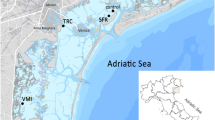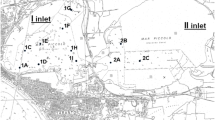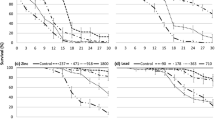Abstract
Purpose
Acute whole-sediment bioassay with the estuarine and marine amphipod Corophium volutator (Pallas) is widely used to assess toxicity of sediments. According to the guidelines DIN EN ISO 16712, mortality is the determined toxic endpoint. Additionally, the reburrowing ability of the surviving organisms of this acute toxicity test in fresh uncontaminated sediment is suggested as the sublethal endpoint, but insufficient information (e.g., exact measurement protocols) on this endpoint is provided, thus confounding factors and the interpretation of the results. The aim of this study was to provide information on burrowing activity as a sublethal endpoint.
Materials and methods
Amphipod tests were carried out in the laboratory, and the burrowing behavior was examined in a size- and gender-specific manner. For sediment testing, only animals of the same size were used in a defined sex ratio because it was found that female animals buried themselves faster than males and that smaller animals burrowed faster than bigger organisms. Statistical analyses were applied to determine whether burrowing time and ability differ significantly between sexes and sizes. Finally, tests were run to discern whether the burrowing ability could be a more sensitive endpoint than mortality.
Results and discussion
When the burrowing ability was examined in toxicity tests with contaminated sediment, the test organisms were affected in a dose-dependent manner. With rising concentrations of the contaminated sediment in a sublethal testing following the sediment exposure over 10 days, fewer animals buried themselves into the sediment.
Conclusions
The burrowing behavior can be used as an additional endpoint. For the tested sediment, burrowing was found to be more sensitive than the mortality. Guidance on the measurement protocol for this additional endpoint was developed. Under the test conditions examined, burrowing ability is an appropriate sublethal endpoint to supplement the toxicity test procedure.




Similar content being viewed by others
Notes
The sample was obtained from the sediment surface with a Van Veen grab sampler in 2006. An analysis of the chemical load was performed by the Gesellschaft für Bioanalytik Hamburg mbH, Hamburg (dry weight acc. DIN ISO 11465: 33.9 % w/w; particle size distribution acc. DIN 18123 per weight dry mass: <20 μm 55 %, 20–60 μm 14 %, 60–200 μm 10 %, 200–600 μm 14 %, 600–2,000 μm 4 %, >2,000 μm 3 %; TOC acc. DIN EN 13137: 15 % w/w dm; heavy metals in the fraction <20 μm acc. DIN EN ISO 11885-E22 based on dry mass: arsenic 116 mg/kg, lead 978 mg/kg, cadmium 20 mg/kg, chrome 152 mg/kg, copper 450 mg/kg, nickel 96 mg/kg, zinc 2,460 mg/kg; mercury acc. DIN EN 1483-E12: 16 mg/kg; petroleum-derived hydrocarbon acc. DIN ISO 16703: 33 g/kg w/w dm; sum chlorobenzene analog to DIN EN ISO 6468-F1: 624 μg/kg dm; sum polychlorinated biphenyls analog to DIN 38414–20, DIN 38407–2: 300 μg/kg dm; hexachlorocyclohexane analog to DIN 38414–20, DIN 38407–2: α-HCH: 18 μg/kg dm, β-HCH: <0.2 μg/kg dm, γ-HCH 13 μg/kg dm: polycyclic aromatic hydrocarbons (sum PAH EPA) via GC-MSD acc. Merkbl. 1 LUA-NRW: 5,260 mg/kg dm).
References
ASTM (1991) Annual book of ASTM standards. American Society of Testing and Materials Vol. 11.04, Philadelphia, USA
Bat L, Raffaelli D (1998) Sediment toxicity testing: a bioassay approach using the amphipod Corophium volutator and the polychaete Arenicola marina. J Exp Mar Biol Ecol 226:217–239
Bat L, Raffaelli D, Marr IL (1998) The accumulation of copper, zinc and cadmium by the amphipod Corophium volutator (Pallas). J Exp Mar Biol Ecol 223:167–184
Briggs AD, Greenwood N, Grant A (2003) Can turbidity caused by Corophium volutator (Pallas) activity be used to assess sediment toxicity rapidly? Mar Environ Res 55:181–192
Campbell JI, Meadows PS (1974) Gregarious behavior in a benthic marine amphipod (Corophium volutator). Experientia 30:1396–1397
Castro H, Ramalheira F, Quintino V, Rodrigues AM (2006) Amphipod acute and chronic sediment toxicity assessment in estuarine environmental monitoring: an example from Ria de Aveiro, NW Portugal. Mar Pollut Bull 53:91–99
CEFAS (1997) Final report of the sediment bioassay task team. Science series aquatic environment monitoring report number 48. Marine Pollution Monitoring Management Group, CEFAS, Lowestoft
DIN EN ISO 16712 (2007) Wasserbeschaffenheit—Bestimmung der akuten Toxizität mariner Sedimente oder von Sedimenten aus Flussmündungen gegenüber Amphipoden. In: Deutsche Einheitsverfahren zur Wasser-, Abwasser- uns Schlamm-Untersuchung. Wiley, Berlin, DIN EN ISO 16712:2007(L50)
Drolet D, Barbeau MA (2009) Differential emigration causes aggregation of the amphipod Corophium volutator (Pallas) in tide pools on mudflats of the upper Bay of Fundy, Canada. J Exp Mar Biol Ecol 370:41–47
Erdem C, Meadows PS (1980) The influence of mercury on the burrowing behavior of Corophium volutator. Mar Biol 56:233–237
Fenchel T, Kofoed LH, Lappalainen A (1975) Particle size selection of 2 deposit feeders—amphipod Corophium volutator and prosobranch Hydrobia ulvae. Mar Biol 30:119–128
Fish JD, Mills A (1979) Reproductive-biology of Corophium volutator and Corophium arenarium (Crustacea, Amphipoda). J Mar Biol Assoc UK 59:355–368
Floeter C (2006) Entwicklung von ökotoxikologischen Instrumenten und ihre rechtliche Implementierung zur marinen ökologischen Risikobewertung von Chemikalien, Pestiziden und Baggergut. Dissertation, Technische Universität Hamburg-Harburg, Germany
Hart T (1930) Preliminary notes on the bionomics of the Amphipod, Corophium volutator Pallas. J Mar Biol Assoc UK 16:761–789
Hellou J, Cheeseman K, Jouvenelle ML, Robertson S (2005) Behavioral response of Corophium volutator relative to experimental conditions, physical and chemical disturbances. Environ Toxicol Chem 24:3061–3068
Ingle RW (1966) An account of burrowing behaviour of amphipod Corophium arenarium Crawford (Amphipoda–Corophidae). Ann Mag Nat Hist 9:309
Krang AS, Baden SP (2004) The ability of the amphipod Corophium volutator (Pallas) to follow chemical signals from con-specifics. J Exp Mar Biol Ecol 310:195–206
Krebs F (2005) The pT-method as a hazard assessment scheme for sediments and dredged material. In: Blaise C, Férard JF (eds) Small-scale freshwater toxicity investigations, volume 2: Hazard assessment schemes. Springer, Dordrecht, pp 281–304
Lawrie SM, Raffaelli DG (1998) In situ swimming behaviour of the amphipod Corophium volutator (Pallas). J Exp Mar Biol Ecol 224:237–251
Marsden ID, Wong CHT (2001) Effects of sediment copper on a tube-dwelling estuarine amphipod, Paracorophium excavatum. Mar Freshwater Res 52:1007–1014
McCready S, Spyrakis G, Greely CR, Birch GF, Long ER (2004) Toxicity of surficial sediments from Sydney Harbour and vicinity, Australia. Environ Monit Assess 96:53–83
McCready S, Birch GF, Long ER, Spyrakis G, Greely CR (2006) Relationships between toxicity and concentrations of chemical contaminants in sediments from Sydney Harbour, Australia, and vicinity. Environ Monit Assess 120:187–220
McCurdy DG, Forbes MR, Boates JS (1999a) Testing alternative hypotheses for variation in amphipod behaviour and life history in relation to parasitism. Int J Parasitol 29:1001–1009
McCurdy DG, Forbes MR, Boates JS (1999b) Evidence that the parasitic nematode Skrjabinoclava manipulates host Corophium behavior to increase transmission to the sandpiper, Calidris pusilla. Behav Ecol 10:351–357
Meadows PS (1964) Substrate selection by Corophium species—the particle-size of substrates. J Anim Ecol 33:387–394
Meadows PS, Tait J (1989) Modification of sediment permeability and shear-strength by 2 burrowing invertebrates. Mar Biol 101:75–82
Melo SLR, Nipper M (2007) Sediment toxicity tests using the burrowing amphipod Tiburonella viscana (Amphipoda: Platyischnopidae). Ecotox Environ Safe 66:412–420
Nendza M (2002) Inventory of marine biotest methods for the evaluation of dredged material and sediments. Chemosphere 48:865–883
Noack U, Becker S, Kraetzig G (2003) Marine biotest: comparative investigations on acute toxicity of ammonium chloride to Corophium volutator. Fresen Environ Bull 12:608–612
Peters C, Ahlf W (2005) Reproduction of the estuarine and marine amphipod Corophium volutator (Pallas) in laboratory for toxicity testing. Chemosphere 59:525–536
R Development Core Team (2008) R: A language and environment for statistical computing. R Foundation for Statistical Computing, Vienna
Scarlett A, Canty MN, Smith EL, Rowland SJ, Galloway TS (2007a) Can amphipod behavior help to predict chronic toxicity of sediments? Hum Ecol Risk Assess 13:506–518
Scarlett A, Galloway TS, Rowland SJ (2007b) Chronic toxicity of unresolved complex mixtures (UCM) of hydrocarbons in marine sediments. J Soil Sediment 7:200–206
Schlekat CE, Decho AW, Chandler GT (2000) Bioavailability of particle-associated silver, cadmium, and zinc to the estuarine amphipod Leptocheirus plumulosus through dietary ingestion. Limnol Oceanogr 45:11–21
Schneider SD, Boates JS, Forbes M (1994) Sex-ratios of Corophium volutator (Pallas) (Crustacea, Amphipoda) in Bay of Fundy populations. Can J Zool 72:1915–1921
Sokal RR, Rohlf FJ (1995) Biometry: the principles and practice of statistics in biological research. W H Freeman and Co., New York
Swartz RC, Deben WA, Cole FA (1979) Bioassay for the toxicity of sediment to marine macrobenthos. J Water Pollut Con F 51:944–950
Swartz RC, Ditsworth GR, Schults DW, Lamberson JO (1986) Sediment toxicity to a marine infaunal amphipod—cadmium and its interaction with sewage-sludge. Mar Environ Res 18:133–153
US Army Corps of Engineers (2008) Overview of Corps National Dredging Program and Regulations. From Dredged Material Management Training. Sacramento, CA
Wilson WH (1989) Predation and the mediation of intraspecific competition in an infaunal community in the Bay of Fundy. J Exp Mar Biol Ecol 132:221–245
Yeager DP, Ultsch GR (1989) Physiological regulation and conformation: a BASIC program for the determination of critical point. Physiol Zool 62:888–907
Acknowledgments
We would like to thank Bernd Uebelmann and Shane Denecke for linguistic comments. The views and conclusions contained in this paper are those of the authors and should not be interpreted as representing the opinions or policies of the German Federal Institute of Hydrology (BfG) or the German Government.
Author information
Authors and Affiliations
Corresponding author
Additional information
Responsible editor: Wolfgang Ahlf
Rights and permissions
About this article
Cite this article
Siebeneicher, S., Wahrendorf, DS., Wetzel, M.A. et al. Analysis of burrowing ability as a sublethal endpoint in a marine sediment bioassay with Corophium volutator (Pallas). J Soils Sediments 13, 197–206 (2013). https://doi.org/10.1007/s11368-012-0619-5
Received:
Accepted:
Published:
Issue Date:
DOI: https://doi.org/10.1007/s11368-012-0619-5




